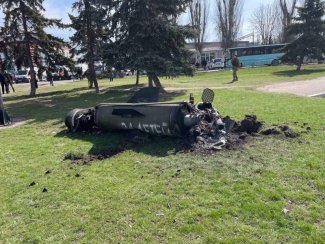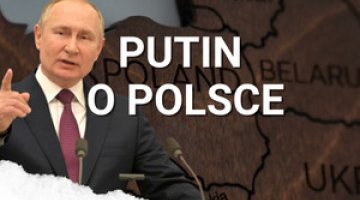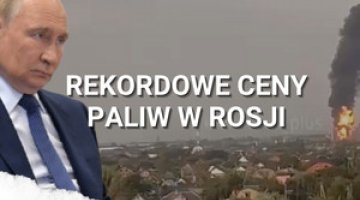Russia’s attack on Ukraine: day 50

Russian troops are continuing preparations for an offensive operation in eastern Ukraine. To this end, they are relocating subunits of the 36th Combined Arms Army (CAA) of the Eastern Military District (MD) from the Gomel Oblast, increasing the air grouping and decontaminating stored arms and military equipment. Additional subunits from the 8th CAA of the Southern MD and from the Northern Fleet are to be prepared for combat operations. Assessment of the state of affairs continues to be hampered by the increasingly laconic nature of the communiqués of the General Staff of the Armed Forces of Ukraine, which report that the situation on the directions of defence remains unchanged. The evening message of 14 April focused on the aggressor’s problems with replenishing losses, which in the case of the 126th Coastal Defence Brigade (mechanised) and the 127th Reconnaissance Brigade from the 22nd Army Corps of the Black Sea Fleet are expected to be above 50%. According to the Ukrainian side, the Russians cannot execute the mobilisation plan in the North Caucasus region due to the reluctance of the population to participate in the war. The situation with the completion of units is said to be critical, and the command of the Armed Forces of the Russian Federation reportedly intends to initiate a process of nationwide mobilisation, which would be masked by a planned conscription for military service.
The invading forces are to attack Slavyansk from the Donbas side, as well as prepare an assault on this city with forces from the Kharkiv Oblast. On the Slobozhansky direction of the defence, Russian forces were to launch four attacks resulting in ongoing clashes, prepare an assault on Barvinkove, and continue a partial blockade of Kharkiv (the city was shelled and bombed for another 24 hours). In Donbas, the defenders were to repel eight enemy attacks. In the Luhansk Oblast, street fighting continues in Popasna and Rubizhne (the defenders were to prevent the attackers from entering the centres of both towns), the enemy was to storm Novotoshkivs’ke. Sievierodonetsk was also mentioned in the context of active actions by the aggressor. In the Donetsk Oblast, clashes continued ‘along the entire front line’, with 11 towns north and west of Donetsk being shelled and bombed. The part of Mariupol, which remained under Ukrainian control, was also bombed (most likely only the Azovstal combine).
On the border of Kherson Oblast with Mykolaiv and Dnipropetrovsk oblasts, the invaders are expected to continue to consolidate positions and shell villages controlled by defenders (local authorities have named 20 of them). There has been a local exchange of prisoners. For the first time since its withdrawal from the northern part of the country, the aggressor shelled the border areas of the Chernihiv Oblast (including Horodnia) and the southern part of the Sumy Oblast (near the villages of Okhtyrka and Velyka Pysarivka). During the night, the Russians were to carry out more than 30 missile strikes on targets across Ukraine (Synelnykove in Dnipropetrovsk Oblast, Vasylkiv in Kyiv Oblast, machine-building facilities in Kyiv’s Zhuliany district), but information about them is perfunctory. On 14 April, in the evening, in the Black Sea, the Russian missile cruiser ‘Moskva’, severely damaged the previous day, sank.
In an interview with the BBC, President Volodymyr Zelensky announced that the Ukrainian army’s grouping in the Donbas numbered 44,000 soldiers. In turn, the US Department of Defence estimates the current Russian involvement in southern and eastern Ukraine at 65 battalion tactical groups. However, it points out that the aggressor is introducing more subunits into the country.
On 14 April, another, fourth official exchange of prisoners took place. The Russian side handed over 30 people; however, there was no announcement on how many POWs Ukraine handed over. In addition, in the Kherson Oblast, four Russian soldiers were exchanged for five Ukrainian ones.
The Mariupol City Council reported that the occupation forces were carrying out exhumations of corpses in the city, and Ukrainian intelligence noted the presence of 13 mobile crematoria there. The Russians were said to have banned residents from carrying out further burials. The bodies of those killed are also to be cremated collectively in Kharkiv near Donetsk to help cover up the scale of the killings.
The Counter-Disinformation Centre of the National Security and Defence Council of Ukraine has reported that the Russians have launched military provocations aimed at justifying further military activity. The aggressor is to carry out shelling of its own border posts and accuse Ukrainian diversionary groups of doing so. At the same time, the FSB reported the shelling of the border crossing point at Novye Yurkovichi in the Bryansk Oblast, where a group of several dozen refugees deported from the areas affected by the hostilities were said to be located. The Ukrainian army also allegedly fired artillery at several villages on the Russian side and wounded seven residents, including children and a pregnant woman.
On 14 April, 2,557 people used the humanitarian corridors, mostly from the Zaporizhzhia Oblast. Nine green corridors are scheduled for 15 April: to Zaporizhzhia from towns in Donetsk Oblast and to Bakhmut from towns in Luhansk Oblast. Ukrainian Railways has launched six evacuation trains.
On 14 April, the Verkhovna Rada adopted more than 20 bills, including a resolution recognising Russian actions as crimes of genocide against the Ukrainian nation. It stated that the aggressor’s troops were carrying out a planned and systematic act of destruction of the Ukrainian people and their identity, and deprived them of the right to self-determination and independent development. It also provides for an appeal to international organisations, the European Parliament and the governments of other countries to recognise the acts of the Russian forces in Ukraine as genocidal. In addition, a law increasing criminal liability for collaborators to 10–12 years imprisonment was adopted, and the use of the symbols of the invading forces was banned. The Rada also voted through amendments to the law on military service, specifying the period of contractual military service for foreigners and non-citizens (three years for privates, three to five years above the rank of sergeant) and allowing termination of the contract during the declaration of mobilisation and martial law. Parliament also adopted amendments to the Intelligence Act – these provide for the right for foreigners and non-citizens to join the intelligence services during martial law. Almost all the documents were adopted by a constitutional majority (more than 300 votes), which demonstrates the continuing consensus among the political elite. The parliamentary faction of the pro-Russian Opposition Platform – For Life (OPFL) was dissolved on the basis of an earlier decision by the National Security and Defence Council to suspend it for the duration of martial law. The meeting began with speeches by the Marshal of the Polish Senate Tomasz Grodzki and the President of the Czech Senate Miloš Vystrčil.
President Zelensky said that the scale of the crimes in the towns near Kyiv provokes extreme emotions and closes the possibility of dialogue with Moscow, and that Russia’s actions mean that ‘there are not many chances left for talks with Ukrainians’. He also admitted that he felt only hatred towards the soldiers of the aggressor, while he described the political and military leadership of the Russian Federation as war criminals.
According to media reports, the US is planning a visit by high-level officials to Kyiv as a sign of solidarity with Ukraine. Secretary of State Antony Blinken or Defence Secretary Lloyd Austin are mentioned in this context. President Joe Biden did not rule out in an interview that he himself would go to Kyiv. A telephone conversation between Zelensky and Emmanuel Macron took place on 14 April. France announced the donation of 24 ambulances and fire engines and 50 tonnes of rescue equipment to Ukraine.
The National Bank of Ukraine (NBU) forecasts that inflation this year could exceed 20%. In March, prices rose by 13.7% compared to the same month last year. Despite this, the NBU did not increase the main reference rate, which is 10%. It also maintained a fixed exchange rate of 29.25 hryvnias per dollar.
According to data from the Polish Border Guard, 2.76 million people have left Ukraine for Poland since the beginning of the war, and 26.8 thousand on 14 April (an 8% increase on the previous day). Since 24 February, 652,000 people have crossed the border in the opposite direction.
Commentary
- The information provided by Kyiv and the Pentagon about the numbers of the warring parties’ groupings gives a relative picture of their military potentials. The 65 Russian battalion tactical groups (BTG), including support and security sub-units operating outside them, can be roughly calculated at 65,000 soldiers. If we take into account the American data from a few days ago about the involvement of 30 BTGs in Donbas, this would mean that the ratio of forces in the crucial area of clashes is four to three in favour of the Ukrainian army. However, the aggressor has an advantage in terms of equipment and air support, which is currently symbolic on the defenders’ side. In addition, the Russians maintain at least 20 BTG at the border with eastern Ukraine, and their forces are expected to grow. It remains an open question what potential the Ukrainian Armed Forces have amassed in other directions and which they can use to support operations in Donbas. At the beginning of the war, the number of regular and territorial defence units of the defenders exceeded 300,000 soldiers (as against 150,000–200,000 troops of the invaders). It must be assumed that, while they still have a relatively large number of soldiers at their disposal, they lack the armament to effectively conduct offensive operations.
- The drastic reduction in the Ukrainian army’s command structures’ coverage of the military situation on the border between Kharkiv and Donetsk oblasts observed in recent days is most likely due to the deteriorating position of the defenders. The media are still reporting perfunctorily on the fighting in or towards Izyum. Ukrainian positions are now about 30 km to the south, and the aggressor has approached Barvinkove and Slavyansk. For more than a day there have been references to attacking Slavyansk also from the Donbas side, but Ukrainian sources do not specify whether this is an attack by part of a grouping operating in the Luhansk Oblast in the Sievierodonetsk area (from the east) or a breakthrough of the defenders’ positions north of Horlivka (from the south). However, the concentration of the aggressor’s forces operating from two directions in the Sloviansk region means that the Ukrainian grouping in the Sievierodonetsk area (the last defenders’ grouping in the Luhansk Oblast) is currently locked in a cauldron or has already been encircled.
- The information provided by the Russian services and media about the alleged shelling and diversionary actions taken by Ukrainian soldiers in the border areas of the Russian Federation is intended to further consolidate Russian society around the Kremlin and to justify the expected escalation of aggression. It is also intended to create the impression of symmetry in the actions of both sides, in the face of data published in Western mass media about war crimes committed by Russians in Ukraine.
- The dissolution of the OPFL faction is another step in the liquidation of the main pro-Russian force in Ukraine. Until the outbreak of the war, it was the second largest in the Verkhovna Rada (44 deputies). The aggression caused the withdrawal of some MPs – the faction shrank to 34, but still remained the largest opposition parliamentary group. The faction’s dissolution means that it will no longer be able to take up leadership positions in Council committees. Proceedings for the total banning of OPFL are pending in court.





